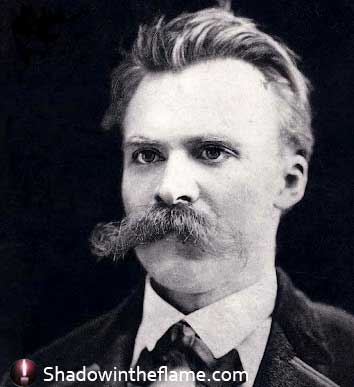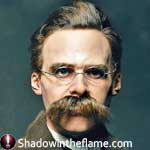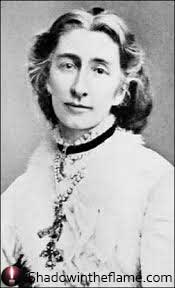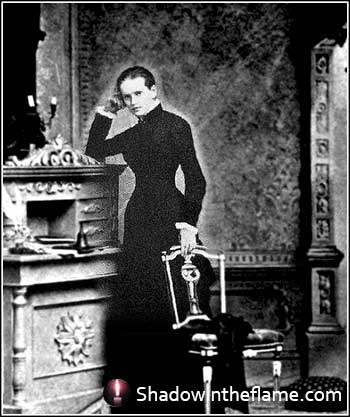 Friedrich Nietzsche
Friedrich Nietzsche
Chapter 3 of The Man draws strongly on the philosophy of Friedrich Nietzsche, certainly one of the greatest philosophical writers of the nineteenth century and one of my personal favourites. So before I embark on the analysis of chapter 3 I thought it would be a good idea to introduce you to Nietzsche.
This is not a biography; It is more a snap shot about one aspect of his life that I think has not been covered in detail and yet the more I read him, the more convinced I am, that it was a major driving force in Nietzsche’s writing.
You could say it drove him “mad” but of course his eventual collapse had more to do with the syphilis he contracted on his first and possibly, his only sexual encounter. However, I believe that the sexual tension Nietzsche experienced all his life is central to understanding his philosophy and I want to look at that aspect in more detail than is usual.
Nietzsche’s Problem with Sex
In 1865 Nietzsche visited a Cologne brothel with some fellow students from Bonn University. This was not unusual at the time as it was quite common for German University students in the 1860s and 1870s to learn about sex this way and it would have been unusual if he had not visited a brothel at least once.
However, Nietzsche told his friend Paul Deussen, that he was taken there against his will and left immediately. But as Nietzsche subsequently contracted and eventually died from syphilis this is probably a white lie.
Nietzsche was first treated for a syphilitic infection in 1867 in Leipzig and suffered his first incapacitation in 1871. The course of his illness from 1871 up until his total collapse in 1889 is quite typical of the disease. The only unusual aspect was how long it took for him to die after his collapse. It took eleven (11) years and for practically all of this period he was in a catatonic state having suffered a complete mental breakdown.
Nietzsche suffered from debilitating headaches and bouts of depression and euphoria all his life. The final mental breakdown happened when he was in Italy in 1889. While walking through the piazza Carlo Alberto in Turin, he saw a carthorse being whipped by the driver and immediately jumped to its aid wrapping his arms around its neck, crying and pleading with it for forgiveness.
While Nietzsche never admitted to having syphilis H. W. Brann in his book on Nietzsche’s sex life, Nietzsche und die Frauen, interprets the long poem in the chapter “Among the Daughters of the Desert” in part four of Zarathustra as a barely disguised recollection of a visit to a brothel. He noticed similarities between its phraseology and that of the version given to Deussen. (I have added the poem separately if you would like to read it for yourself)
Nietzsche and Women
Many passages in Nietzsche’s writing and especially the uninhibited “Ecco Homo” his “un-autobiography” show that Nietzsche was highly sexed and very attracted to women. Yet there is no record or even a hint that he ever went to bed with a woman of his own class. Taking into account his possible concern for privacy there is still so much other material written about him by his contemporaries that we can safely conclude that her never had sex with a woman from his own class.
Why Did Nietzsche Have a Problem with Sex?
Nietzsche had many women friends but never married or had a mistress. Despite his attraction to women all his relationships suffered from his inhibitions and failure to reach the “next level” i.e. to form a long term relationship, marriage and a healthy sex life.
Most biographers have generally assumed Nietzsche suffered from some paralyzing mental or physical inhibition
 Friedrich Nietzsche
Friedrich Nietzsche
(some speculate it was his huge mustache) that inhibited his relations with women but if there was such an inhibition I think it could well have been his knowledge that he suffered from a disease that would be transmitted to his sexual partner. This theory is supported by our knowledge that Nietzsche was a man of honour which probably led to him leading a celibate life at least in relation to women of his own class. (I know I have mentioned class a few times and while this may seem strange today, it was a very real consideration in the nineteenth century and still is among some people who have delusions of grandeur).
I think this was a huge burden for a man who would have loved nothing more than to meet and marry the right woman and have children. I think it led to a skewing of his views about women but more importantly, it caused him to lead a very solitary and lonely life. Nietzsche was not fortunate enough to find a soul mate with whom he could lead an intellectually stimulating life, which I believe, he would have wanted even if he could have performed sexual intercourse.
Nietzsche’s Two Great Loves
Despite Nietzsche’s “problem” there were two women that we know of for whom Nietzsche really had the hots.
Cosima Wagner
Nietzsche was a close friend of the Wagner’s who he met when he was appointed to the Chair of Classical Philology at Basle University in 1869, aged 24. He shared a common love with them for the pessimistic Schopenhauer who Nietzsche had discovered four years earlier while a student at Leipzig University. Schopenhauer’s philosophy can be summed up as “The prudent man strives for freedom from pain, not pleasure” which is a quote from Aristotle’s Nicomachean Ethics. It was a philosophy that Nietzsche would later eschew (shun).
 Cosima
Cosima
Schopenhauer was not the only one that Nietzsche loved, he fell madly in love with Richard Wagner’s wife Cosima. He never told Cosima of his deep feelings for her until he finally lost his mind in 1889 when he sent her a postcard from Turin in which he wrote ”Ariadne, I love you” and signed it Dionysus.
However, can you imagine the effect that this life long love for Cosima had on Nietzsche which he kept bottled up inside him? Certainly it fueled Nietzsche’s frustration and sense of loneliness and contributed to him making somewhat acerbic comments about women such as “They make the highs higher and the lows more frequent”
Lou Salome
The second true love of his life was Lou Salome (although he did propose to Mathilde Trampedach a few days after meeting her in 1876 but he was rejected). Nietzsche was introduced to Salome by Paul Ree a friend of his who was also in love with her.
Lou Salome was 21, she was the intellectual equal of Friedrich Nietzsche and the least straight laced (Socially uninhibited new style of liberated feminist dedicated to independence) and the most entertaining woman Nietzsche had ever met. She was also frigid and in her Nietzsche thought he had finally found his soul mate.
 Lou Salome
Lou Salome
Amazingly, Nietzsche asked Paul Ree to propose to Salome on his behalf which possibly says something about his emotional IQ.
Salome refused to marry either Nietzsche or Ree and counter proposes a platonic Menage-a-trios (a threesome) with Ree and Nietzsche.
They spend much time together and are photographed in a mock up of a cart with Nietzsche and Ree between the shafts and Salome driving them flourishing a whip. I think this is one of those images when art speaks louder than words.
In May 1882 while the three of them are on a holiday in Lucerne, Nietzsche proposes to Salome again, this time in person. He is rejected and the trio leave for Leipzig where after three weeks Salome and Ree leave Nietzsche without arranging to meet him again.
Nietzsche waits for a month hoping to hear from them before he realises he has been abandoned. By now he is emotionally and physically exhausted and beset with disappointment and self contempt.
The rejection by Salome and not least the manner of it was the bitterest pill Nietzsche ever endured and led to his most severe bout of depression yet. However, part of his strategy to recover his equilibrium was to embark on a new book; Thus Spoke Zarathustra.
Nietzsche’s Crisis Leads to New Philosophy of Hope
One of the things that characterizes Thus Spoke Zarathustra is the excessive and grandiose manner in which it is written. One can feel the depths of Nietzsche’s depression and the inevitable euphoria that usually follows it. I have posted an excerpt from part two, The Night Song, for you to read for yourself.
But Thus Spoke Zarathustra is also the resolution of Nietzsche’s intellectual crisis and he emerges from it with a new philosophy of hope. Hope for a world for which Nietzsche was previously pessimistic.
Nietzsche’s Concept of Fulfillment
It is at this point Nietzsche shakes off the influence of Schopenhauer with his view that:
“……the happiest lot is that of the man who has got through life without any very great pain, bodily or mental.”
and he replaces it with a new philosophy that declares fulfillment in life can only be reached not by avoiding pain but by embracing its role as a natural, inevitable step on the way to achieving anything good.
Nietzsche Emerges from the dark
Thus as Nietzsche emerges from his darkest days he experiences a revelation that all the demolition that goes on in life may be only the essential preliminary and prerequisite condition for a new construction of it. He puts it far more eloquently himself at the end of his book, Dawn:
We aeronauts of the spirit! All those brave birds which fly out into the distance, into the farthest distance – it is certain! somewhere or other they will be unable to go on and will perch down on a mast or a bare cliff-face – and they will be thankful for this miserable accommodation! But who could venture to infer from that, that there was not an immense open space before them, that they had flown as far as one could fly! All our great teachers and predecessors have at last come to a stop…; it will be the same with you and me! But what does that matter to you and me! Other birds will fly farther!
Authors Note:
I sincerely apologise that I have left so much out and yet the article is still too long. I thank you for flying this far with me. Excelsior!
P.S. I have posted separately the two extracts from Thus Spoke Zarathustra mentioned above.
Ric Vatner

